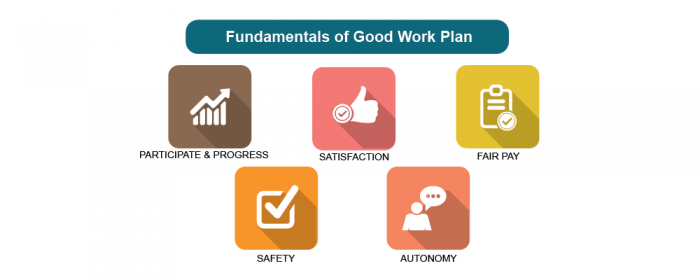Let’s start with a little history of the Good Work Plan (GWP). It will give you an idea of where this write-up is headed. Matthew Taylor reviewed the modern working practices back in 2017 to single-out the issues encountered in the workplace.
Taylor came up with the solutions in a report called Taylor review for the UK government. Its been 3 years and finally the changes are visible in the UK businesses.
It’s just a matter of time when these improvements will make their way to other nations as well if they haven’t already.
So, if you are an employee, it is exigent for you to know about this Good Work Plan and how you can prepare a good work plan.
What is a Good Work Plan?

Let’s start from scratch to understand why this plan was needed in the first place. Basically, a good work plan is another name for the Project Management Plan.
To achieve the ultimate goal at the department or a company level, it is essential to create a coherent and clear work plan.
It should outline the steps needed to be taken by breaking steps into smaller milestones, deliverables, and resources under the given timeline to pile it all together.
The use of a Good Work Plan is suitable when larger projects or ventures are being planned, but it can also be used at any level if required.
Why Do You Need a GWP?
The next step is to realize why you need a work plan. The Work Plan lays a roadmap for the entire project or activity which is under consideration and gives it a proper direction.
It helps keep the teams involved in the project in an organized way and ensures that you can buy-in from key stakeholders of the project or particular activity.
In addition to that, it allows us to manage the expectations on stakeholders’ level as well as on the managerial level.
The Focus of the Good Work Plan
Good Work Plan further focuses on improving three main areas of the United Kingdom’s working life:
- Promise to provide fair and just employment
- The clarity for employers and workers
- Legal transparency resulting in tighter enforcement
Top 5 Fundamentals of the Good Work Plan

There are 5 major principles which lay the foundation in building Good Work Plan to boost work of good quality and relationships:
1. Satisfaction
The 50% of the workforce of today comprises of Millennials, which means that work is no longer restricted to ‘just earn money’.
In Taylor’s report, it was predicted that fulfillment and purpose are the words to look forward to in the office for the year 2020. The modern generation rate job satisfaction was much higher than the previous ones.
By encouraging honesty and transparency, as mentioned earlier, around the job quality, roles, and employee benefits, the Good work Plan anticipates setting ways towards satisfaction.
2. Fair Pay
Lots of discrepancies and inconsistencies were exposed related to remuneration on the Taylor review. The response of the UK Government towards wages and fair pay has been encouraging, with comprehensive guidance, which is now available online.
The primary focus is on equal pay and gender pay gap legislation.
3. Participation and Progression
The space for participation and progression can easily be created by understanding the business and the team thoroughly from inside-out and then understanding and creating different ways to participate and progress.
You should keep an eye out for things that are going well, and areas of improvement must be identified.
The Good Work Plan enables employers to provide simple and clear rules, also known as workers’ statement of rights. It is preferred to do before deciding and appointing the role.
Check this out:
Guide to Creating an Employee Onboarding Checklist
4. Well-being, Safety, and Security
Wellbeing covers every aspect of the life of an individual. From the food and water, to how we move, stretch and breathe, right up to the roof over our heads and the money in our pockets; wellbeing underpins it all.
Safety and security are a major contributing factor to employee job satisfaction. It’s a straightforward fact; a worker who feels safe and has job security would work ten times better than the one who doesn’t.
5. Voice and Autonomy
The Taylor Review states that for work to be fair and decent, workers must have a voice. Employees can only voice their opinions if they are provided with a healthy working environment and encouraging senior management.
You should use weekly one-to-ones, performance reviews, quarterly company meetings, and open-to-all-suggestions board to give your people voice and autonomy.
Preparing for The Good Work Plan
Now that you are all caught up with the GWP, it’s time to create a good work plan. Do not think of it as other company plans where you are left wondering how good does plan b work?
I am sure by now, you are highly impressed by the Good Work Plan. Here’s what you need to do to create one:
1. Identify the Purpose of Your Work Plan.
The purpose is vital. Without it, a work plan means nothing. You must be clear about the purpose for which the work plan is being created.
A purposeful work plan will help your survivors know about the projects you and your team will be working on in the future.
But its use is not only confined to workplaces. For instance, in academics, it can help students while working on a large project or the teachers’ lesson planning.
2. Determine Your Goals & Objectives
Goals and objectives are the cornerstones of the Good Work Plan. They explain what a company aims to achieve through a good work plan.
I feel it is crucial to talk about the difference between goals and objectives; goals are more general while objectives are specific.
Keep your goals broad; they must present the bigger picture of the company’s vision. On the other hand, objectives must be specific, tangible, and relevant.
Once you’re done with this, you will have a clear direction of what your work plan must accomplish.
3. Consider “SMART” objectives
You might have heard about this term. It is a rather popular acronym with the management community. Let’s break it down and see what it means in this context:
i. Specific: In a nutshell, it means to select your audience or target population. The more specific your objectives are, the better will be the productivity.
ii. Measurable: Is it quantifiable, and can you measure it? Can you count the results? The goals and objectives set to be achieved must be measurable at different stages during the project. That way, the progress can be measured ultimately to ensure that all activities are going to finish accordingly or still need to be managed further.
iii. Achievable: The goals must be set so that they must be probable and achievable rather than overly optimistic and overconfidently setting ultra-difficult goals, which might not be achievable in highly idealizing circumstances.
iv. Relevant: Relevancy is of great importance. An organization loses quite a lot if the objective is irrelevant.
v. Time-bound: When will this objective be accomplished, and when will the project come to a closure. Specify a hard end date for the project.
a. Identify any constraints
Constraints are as real as the air we breathe. And inevitable. There will be certain obstacles while executing the Good Work Plan.
A constraint would be an overwhelming schedule, and one would need to cut something out during the project to complete the work plan effectively.
b. Who Is Accountable?
Accountability is essential for a good work plan. Define clearly as to who is responsible for completing what task?
Even if a team delegates to carry out a specific task, one person must speak on behalf of the others and be answerable for the completion of the task.
It’s Your Turn to Make a Move!
You can enjoy the same benefits as the Brits are after implementing the Good Work Plan. It will take some doing on your part. But it is achievable. And highly advantageous.
Today’s highly competitive market has little room for ad hoc methods, intuitions, and impulsive decision-making. A well-managed workflow is bound to succeed.
Start using this plan at your workplace ASAP and see the difference!

